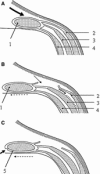Repair of giant midline abdominal wall hernias: "components separation technique" versus prosthetic repair : interim analysis of a randomized controlled trial
- PMID: 17372669
- PMCID: PMC1913177
- DOI: 10.1007/s00268-006-0502-x
Repair of giant midline abdominal wall hernias: "components separation technique" versus prosthetic repair : interim analysis of a randomized controlled trial
Abstract
Background: Reconstruction of giant midline abdominal wall hernias is difficult, and no data are available to decide which technique should be used. It was the aim of this study to compare the "components separation technique" (CST) versus prosthetic repair with e-PTFE patch (PR).
Method: Patients with giant midline abdominal wall hernias were randomized for CST or PR. Patients underwent operation following standard procedures. Postoperative morbidity was scored on a standard form, and patients were followed for 36 months after operation for recurrent hernia.
Results: Between November 1999 and June 2001, 39 patients were randomized for the study, 19 for CST and 18 for PR. Two patients were excluded perioperatively because of gross contamination of the operative field. No differences were found between the groups at baseline with respect to demographic details, co-morbidity, and size of the defect. There was no in-hospital mortality. Wound complications were found in 10 of 19 patients after CST and 13 of 18 patients after PR. Seroma was found more frequently after PR. In 7 of 18 patients after PR, the prosthesis had to be removed as a consequence of early or late infection. Reherniation occurred in 10 patients after CST and in 4 patients after PR.
Conclusions: Repair of abdominal wall hernias with the component separation technique compares favorably with prosthetic repair. Although the reherniation rate after CST is relatively high, the consequences of wound healing disturbances in the presence of e-PTFE patch are far-reaching, often resulting in loss of the prosthesis.
Figures




Comment in
-
Decreasing the reherniation rate using a modified components separation technique.World J Surg. 2007 Nov;31(11):2266, author reply 2267-8. doi: 10.1007/s00268-007-9163-7. World J Surg. 2007. PMID: 17653586 No abstract available.
Similar articles
-
The impact of component separation technique versus no component separation technique on complications and quality of life in the repair of large ventral hernias.Surg Endosc. 2020 Feb;34(2):981-987. doi: 10.1007/s00464-019-06892-x. Epub 2019 Jun 19. Surg Endosc. 2020. PMID: 31218419 Clinical Trial.
-
Interposition of the omentum and/or the peritoneum in the emergency repair of large ventral hernias with polypropylene mesh.Int J Surg. 2014;12(6):578-86. doi: 10.1016/j.ijsu.2014.04.009. Epub 2014 Apr 30. Int J Surg. 2014. PMID: 24793234
-
"Components separation technique" for the repair of large abdominal wall hernias.J Am Coll Surg. 2003 Jan;196(1):32-7. doi: 10.1016/s1072-7515(02)01478-3. J Am Coll Surg. 2003. PMID: 12517546
-
'Sandwich' technique in the treatment of large and complex incisional hernias.ANZ J Surg. 2016 May;86(5):343-7. doi: 10.1111/ans.13285. Epub 2015 Sep 1. ANZ J Surg. 2016. PMID: 26331991 Review.
-
[Abdominal wall closure by incisional hernia and herniation after laparostoma].Chirurg. 2010 Mar;81(3):201-10. doi: 10.1007/s00104-009-1818-5. Chirurg. 2010. PMID: 20145901 Review. German.
Cited by
-
"Complex abdominal wall" management: evidence-based guidelines of the Italian Consensus Conference.Updates Surg. 2019 Jun;71(2):255-272. doi: 10.1007/s13304-018-0577-6. Epub 2018 Sep 25. Updates Surg. 2019. PMID: 30255435 Free PMC article.
-
Abdominal wall component release is a sensible choice for patients requiring complicated closure of abdominal defects.Langenbecks Arch Surg. 2011 Dec;396(8):1263-70. doi: 10.1007/s00423-011-0841-4. Epub 2011 Aug 26. Langenbecks Arch Surg. 2011. PMID: 21870175
-
Flexible tack for ventral hernia repair.Surg Today. 2011 Jul;41(7):1024-5. doi: 10.1007/s00595-010-4373-2. Epub 2011 Jul 12. Surg Today. 2011. PMID: 21748627
-
Difficult abdominal wall closure: component separation versus partition technique.Hernia. 2015 Apr;19(2):301-5. doi: 10.1007/s10029-014-1238-4. Epub 2014 Mar 25. Hernia. 2015. PMID: 24664165
-
Long-term follow-up of full-thickness skin grafting in giant incisional hernia repair: a randomised controlled trial.Hernia. 2022 Apr;26(2):473-479. doi: 10.1007/s10029-021-02544-z. Epub 2021 Dec 14. Hernia. 2022. PMID: 34905143 Free PMC article. Clinical Trial.
References
-
- {'text': '', 'ref_index': 1, 'ids': [{'type': 'DOI', 'value': '10.1056/NEJM200008103430603', 'is_inner': False, 'url': 'https://doi.org/10.1056/nejm200008103430603'}, {'type': 'PubMed', 'value': '10933738', 'is_inner': True, 'url': 'https://pubmed.ncbi.nlm.nih.gov/10933738/'}]}
- Luijendijk RW, Hop WJC, van den Tol MP, et al. A comparison of suture repair with mesh repair for incisional hernia. N Engl J Med 2000;343:392–398 - PubMed
-
- {'text': '', 'ref_index': 1, 'ids': [{'type': 'DOI', 'value': '10.1097/00006534-199009000-00023', 'is_inner': False, 'url': 'https://doi.org/10.1097/00006534-199009000-00023'}, {'type': 'PubMed', 'value': '2143588', 'is_inner': True, 'url': 'https://pubmed.ncbi.nlm.nih.gov/2143588/'}]}
- Ramirez OM, Ruas E, Dellon AL. “Components separation” method for closure of abdominal-wall defects: an anatomic and clinical study. Plast Reconstr Surg 1990;86:519–526 - PubMed
-
- {'text': '', 'ref_index': 1, 'ids': [{'type': 'DOI', 'value': '10.1097/00006534-199609000-00016', 'is_inner': False, 'url': 'https://doi.org/10.1097/00006534-199609000-00016'}, {'type': 'PubMed', 'value': '8700983', 'is_inner': True, 'url': 'https://pubmed.ncbi.nlm.nih.gov/8700983/'}]}
- DiBello JN Jr, Moore JH Jr. Sliding myofascial flap of the rectus abdominus muscles for the closure of recurrent ventral hernias. Plast Reconstr Surg 1996;98:464–469 - PubMed
-
- {'text': '', 'ref_index': 1, 'ids': [{'type': 'DOI', 'value': '10.1097/00000637-199904000-00007', 'is_inner': False, 'url': 'https://doi.org/10.1097/00000637-199904000-00007'}, {'type': 'PubMed', 'value': '10213399', 'is_inner': True, 'url': 'https://pubmed.ncbi.nlm.nih.gov/10213399/'}]}
- Girotto JA, KoMj, Redett R, et al. Closure of chronic abdominal wall defects: a long-term evaluation of the components separation method. Ann Plast Surg 1999;42:385–394 - PubMed
-
- {'text': '', 'ref_index': 1, 'ids': [{'type': 'DOI', 'value': '10.1097/00006534-200107000-00014', 'is_inner': False, 'url': 'https://doi.org/10.1097/00006534-200107000-00014'}, {'type': 'PubMed', 'value': '11432399', 'is_inner': True, 'url': 'https://pubmed.ncbi.nlm.nih.gov/11432399/'}]}
- Cohen M, Morales R Jr, Fildes J, et al. Staged reconstruction after gunshot wounds to the abdomen. Plast Reconstr Surg 2001;108:83–92 - PubMed
Publication types
MeSH terms
Substances
LinkOut - more resources
Full Text Sources
Other Literature Sources
Research Materials

